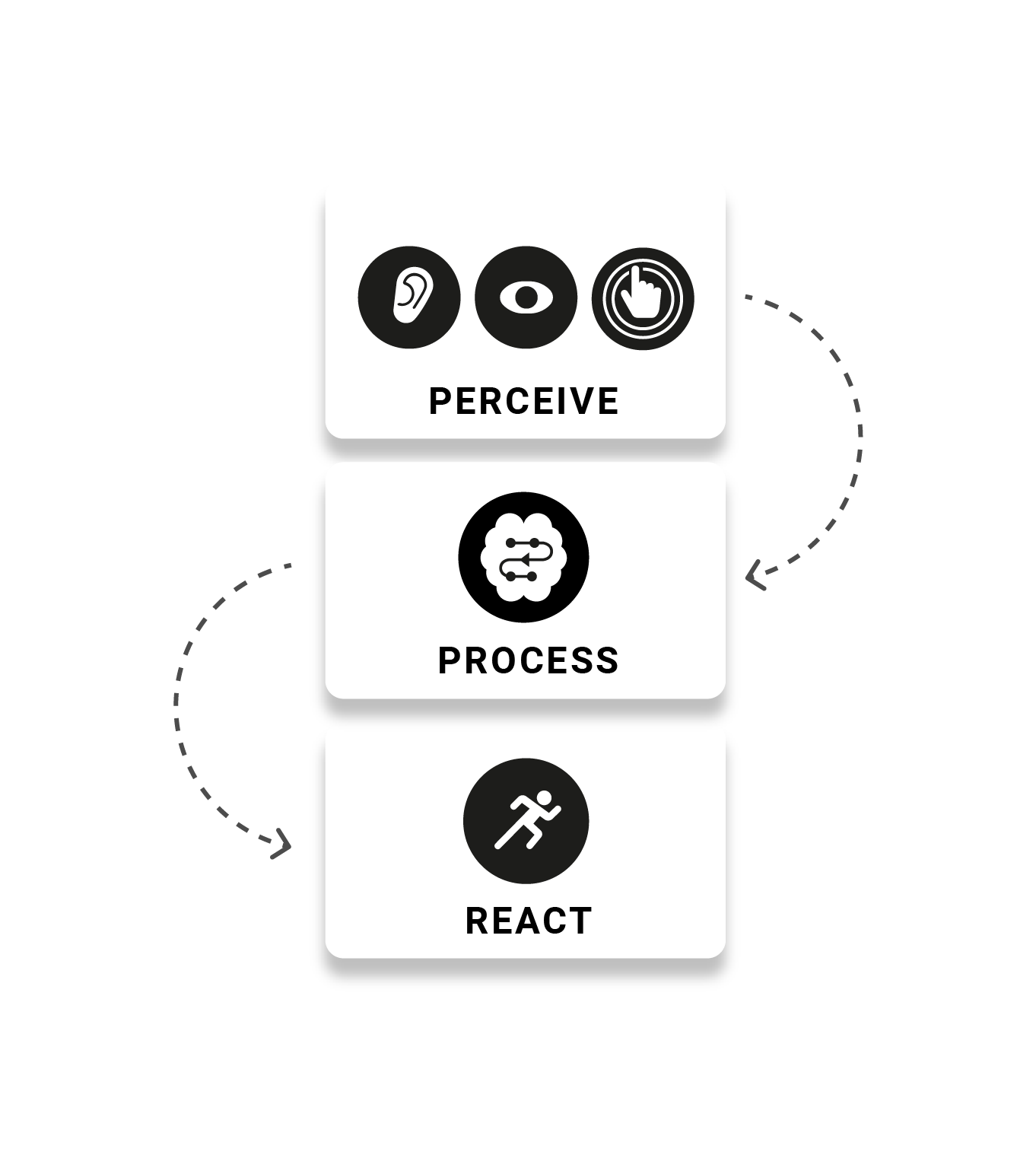THE SCIENCE BEHIND THE ROX TRAINING SYSTEM
IN SPORTS, COMPETITION, AND DAILY LIFE, YOU CONSTANTLY PERCEIVE, PROCESS, AND REACT TO YOUR SURROUNDINGS.

HOW DOES IT WORK?
The ROX pods and training system use A-Champs’ MSNP™ methodology, based on the PERCEIVE, PROCESS, REACT framework.
Randomized light and sound signals from the pods’ sensors require athletes to PERCEIVE them through sight and hearing. The brain PROCESSES these cues — for example, green light to move left and red light to move right — and then commands the muscles to REACT with the proper movement.
For example, a soccer player constantly scans the field, observing opponents and the environment — PERCEIVE. Based on what they see, the player PROCESSES the information and decides to dribble past the opponent on a specific side. After making that decision, they execute the dribble and shoot — REACT.
TEAM SPORTS
Improvement
Examples
1. Visual system optimization
2. Auditive system optimization
3. Kinesthetic system optimization
1. See the ball faster
2. Hear your teammate better
3. Find the correct body position
Decision Making
Quickly select the best teammate to pass the ball to
1. Faster movement of the nervous impulse
2. Greater movement agility
3. Faster speed
4. Better muscle efficiency
5. Higher accuracy
1. Improve your explosive output
2. Dodge your opponents more quickly
3. Run faster towards the goal
4. Conserve energy for the decisive plays
5. Play an accurate pass
1. Faster simple reaction time
2. Faster choice reaction time
1. React faster to a new situation
2. Make quicker choices
Reduced psychological tension
Be less nervous during a game
Greater adaptability and resourcefulness
Adapt to and solve unforeseen situations
1. Better focus
2. Higher motivation
1. Improve your concentration during the match
2. Train harder
INDIVIDUAL SPORTS
Improvement
Example
1. Visual system optimization
2. Auditive system optimization
3. Kinesthetic system optimization
1. See the ball faster
2. Hear your teammate better
3. Find the correct body position
Decision Making
Quickly decide where to play the ball to
1. Faster movement of the nervous impulse
2. Greater movement agility
3. Faster speed
4. Better muscle efficiency
5. Higher accuracy
1. Improve your explosive footwork
2. Reach difficult balls
3. Run faster towards the ball
4. Conserve energy for the decisive plays
5. Hit the right spot
1. Faster simple reaction time
2. Faster choice reaction time
1. React faster to a new situation
2. Make quicker choices where to shoot the ball
Reduced psychological tension
Be less nervous during a game
Greater adaptability and resourcefulness
Adapt to and solve unforeseen situations
1. Better focus
2. Higher motivation
1. Improve your concentration during the match
2. Train harder
PERSONAL TRAINING
Improvement
Example
1. Visual system optimization
2. Auditive system optimization
3. Kinesthetic system optimization
1. See outside signals faster
2. Hear outside signals better
3. Improve your body posture
Decision Making
Make faster decisions
1. Faster movement of the nervous impulse
2. Greater movement agility
3. Faster speed
4. Better muscle efficiency
5. Higher accuracy
Improve your brain - body connection
1. Faster simple reaction time
2. Faster choice reaction time
1. React faster to a situation
2. Make quicker choices
Reduced psychological tension
Be less nervous
Greater adaptability and resourcefulness
Adapt to and solve unforeseen situations
1. Better focus
2. Higher motivation
1. Train in the present
2. Have more fun and train harder
REHABILITATION
Improvement
Example
1. Visual system optimization
2. Auditive system optimization
3. Kinesthetic system optimization
1. Better visual-motor reaction
2. Better auditory-motor reaction
3. Better postural control and proprioceptive reorganization of the injured area
Decision Making
Make faster decisions
1. Faster movement of the nervous impulse
2. Greater movement agility
3. Faster speed
4. Better muscle efficiency
5. Higher accuracy
1. Improvement of nerve transmission to the injured area
2. Improvement of movement after a period of immobilization
3. Improvement of the movement speed after a period of immobilization
4. Muscle reactivation
5. Specific skill improvement
1. Faster simple reaction time
2. Faster choice reaction time
Improvement of the recovery process due to increased reaction time
Reduced psychological tension
Be less nervous
Greater adaptability and resourcefulness
Re-learn patterns of movement that were forgotten due to immobilization
1. Better Focus
2. Higher Motivation
1. Forget injury and physical limitations due to playful character
2. Make the hard work fun
PHYSICAL EDUCATION
Improvements
Examples
1. Visual system optimization
2. Auditive system optimization
3. Kinesthetic system optimization
1. Improve vision
2. Improve hearing
3. Improve body position
Better focus on relevant information
Learn to eliminate non-relevant information
1. Faster movement of the nervous impulse
2. Greater movement agility
3. Faster speed
4. Better muscle efficiency
5. Higher accuracy
1. Improve your explosive output
2. Improve spatial awareness
3. Run faster
4. Improve muscle efficiency
5. Improve specific skills
1. Faster simple reaction time
2. Faster choice reaction time
1. React faster to a new situation
2. Make quicker choices
Reduced psychological tension
Cope better with stress
Greater adaptability and resourcefulness
Develop new patterns of movement that will help to be better coordinated

